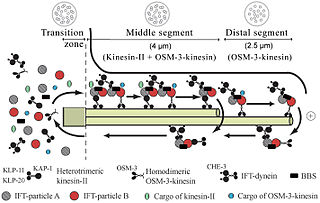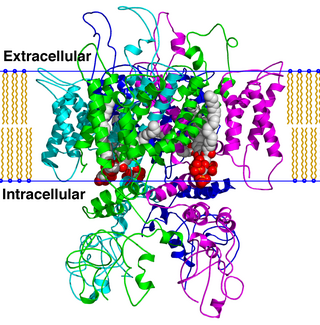
Condensins are large protein complexes that play a central role in chromosome assembly and segregation during mitosis and meiosis. Their subunits were originally identified as major components of mitotic chromosomes assembled in Xenopus egg extracts.

Intraflagellar transport (IFT) is a bidirectional motility along axoneme microtubules that is essential for the formation (ciliogenesis) and maintenance of most eukaryotic cilia and flagella. It is thought to be required to build all cilia that assemble within a membrane projection from the cell surface. Plasmodium falciparum cilia and the sperm flagella of Drosophila are examples of cilia that assemble in the cytoplasm and do not require IFT. The process of IFT involves movement of large protein complexes called IFT particles or trains from the cell body to the ciliary tip and followed by their return to the cell body. The outward or anterograde movement is powered by kinesin-2 while the inward or retrograde movement is powered by cytoplasmic dynein 2/1b. The IFT particles are composed of about 20 proteins organized in two subcomplexes called complex A and B.
SMC complexes represent a large family of ATPases that participate in many aspects of higher-order chromosome organization and dynamics. SMC stands for Structural Maintenance of Chromosomes.

Cohesin is a protein complex that mediates sister chromatid cohesion, homologous recombination, and DNA looping. Cohesin is formed of SMC3, SMC1, SCC1 and SCC3. Cohesin holds sister chromatids together after DNA replication until anaphase when removal of cohesin leads to separation of sister chromatids. The complex forms a ring-like structure and it is believed that sister chromatids are held together by entrapment inside the cohesin ring. Cohesin is a member of the SMC family of protein complexes which includes Condensin, MukBEF and SMC-ScpAB.
Molecular mimicry is the theoretical possibility that sequence similarities between foreign and self-peptides are enough to result in the cross-activation of autoreactive T or B cells by pathogen-derived peptides. Despite the prevalence of several peptide sequences which can be both foreign and self in nature, just a few crucial residues can activate a single antibody or TCR. This highlights the importance of structural homology in the theory of molecular mimicry. Upon activation, these "peptide mimic" specific T or B cells can cross-react with self-epitopes, thus leading to tissue pathology (autoimmunity). Molecular mimicry is one of several ways in which autoimmunity can be evoked. A molecular mimicking event is more than an epiphenomenon despite its low probability, and these events have serious implications in the onset of many human autoimmune disorders.

TRPV is a family of transient receptor potential cation channels in animals. All TRPVs are highly calcium selective.

Structural maintenance of chromosomes protein 1A (SMC1A) is a protein that in humans is encoded by the SMC1A gene. SMC1A is a subunit of the cohesin complex which mediates sister chromatid cohesion, homologous recombination and DNA looping. In somatic cells, cohesin is formed of SMC1A, SMC3, RAD21 and either SA1 or SA2 whereas in meiosis, cohesin is formed of SMC3, SMC1B, REC8 and SA3.

Double-strand-break repair protein rad21 homolog is a protein that in humans is encoded by the RAD21 gene. RAD21, an essential gene, encodes a DNA double-strand break (DSB) repair protein that is evolutionarily conserved in all eukaryotes from budding yeast to humans. RAD21 protein is a structural component of the highly conserved cohesin complex consisting of RAD21, SMC1A, SMC3, and SCC3 [ STAG1 (SA1) and STAG2 (SA2) in multicellular organisms] proteins, involved in sister chromatid cohesion.

Structural maintenance of chromosomes protein 4 (SMC-4) also known as chromosome-associated polypeptide C (CAP-C) or XCAP-C homolog is a protein that in humans is encoded by the SMC4 gene. SMC-4 is a core subunit of condensin I and II, large protein complexes involved in high order chromosome organization, including condensation and segregation. SMC-4 protein is commonly associated with the SMC-2 protein, another protein complex within the SMC protein family. SMC-4 dimerizes with SMC-2, creating the flexible and dynamic structure of the condensin holocomplex. An over-expression of the SMC-4 protein is shown to impact carcinogenesis.

Structural maintenance of chromosomes protein 5 is a protein encoded by the SMC5 gene in human.

Condensin complex subunit 2 also known as chromosome-associated protein H (CAP-H) or non-SMC condensin I complex subunit H (NCAPH) is a protein that in humans is encoded by the NCAPH gene. CAP-H is a subunit of condensin I, a large protein complex involved in chromosome condensation. Abnormal expression of NCAPH may be linked to various types of carcinogenesis as a prognostic indicator.

Structural maintenance of chromosomes protein 2 (SMC-2), also known as chromosome-associated protein E (CAP-E), is a protein that in humans is encoded by the SMC2 gene. SMC2 is part of the SMC protein family and is a core subunit of condensin I and II, large protein complexes involved in chromosome condensation, overall organization. Several studies have demonstrated the necessity of SMC2 for cell division and proliferation.

Protein phosphatase 2 (PP2), also known as PP2A, is an enzyme that in humans is encoded by the PPP2CA gene. The PP2A heterotrimeric protein phosphatase is ubiquitously expressed, accounting for a large fraction of phosphatase activity in eukaryotic cells. Its serine/threonine phosphatase activity has a broad substrate specificity and diverse cellular functions. Among the targets of PP2A are proteins of oncogenic signaling cascades, such as Raf, MEK, and AKT, where PP2A may act as a tumor suppressor.
Molybdopterin synthase (EC 2.8.1.12, MPT synthase) is an enzyme required to synthesize molybdopterin (MPT) from precursor Z (now known as cyclic pyranopterin monophosphate). Molydopterin is subsequently complexed with molybdenum to form molybdenum cofactor (MoCo). MPT synthase catalyses the following chemical reaction:

Condensin-2 complex subunit H2, also known as chromosome-associated protein H2 (CAP-H2) or non-SMC condensin II complex subunit H2 (NCAPH2), is a protein that in humans is encoded by the NCAPH2 gene. CAP-H2 is a subunit of condensin II, a large protein complex involved in chromosome condensation.

Structural maintenance of chromosomes protein 1B (SMC-1B) is a protein that in humans is encoded by the SMC1B gene. SMC proteins engage in chromosome organization and can be broken into 3 groups based on function which are cohesins, condensins, and DNA repair. SMC-1B belongs to a family of proteins required for chromatid cohesion and DNA recombination during meiosis and mitosis. SMC1B protein appears to participate with other cohesins REC8, STAG3 and SMC3 in sister-chromatid cohesion throughout the whole meiotic process in human oocytes.
Shelterin is a protein complex known to protect telomeres in many eukaryotes from DNA repair mechanisms, as well as to regulate telomerase activity. In mammals and other vertebrates, telomeric DNA consists of repeating double-stranded 5'-TTAGGG-3' (G-strand) sequences along with the 3'-AATCCC-5' (C-strand) complement, ending with a 50-400 nucleotide 3' (G-strand) overhang. Much of the final double-stranded portion of the telomere forms a T-loop (Telomere-loop) that is invaded by the 3' (G-strand) overhang to form a small D-loop (Displacement-loop).
Chloride channel openers refer to a specific category of drugs designed to modulate chloride channels in the human body. Chloride channels are anion-selective channels which are involved in a wide variety of physiological functions and processes such as the regulation of neuroexcitation, transepithelial salt transport, and smooth muscle contraction. Due to their distribution throughout the body, diversity, functionality, and associated pathology, chloride channels represent an ideal target for the development of channel modulating drugs such as chloride channel openers.

An array of protein tandem repeats is defined as several adjacent copies having the same or similar sequence motifs. These periodic sequences are generated by internal duplications in both coding and non-coding genomic sequences. Repetitive units of protein tandem repeats are considerably diverse, ranging from the repetition of a single amino acid to domains of 100 or more residues.
Xenopus egg extract is a lysate that is prepared by crushing the eggs of the African clawed frog Xenopus laevis. It offers a powerful cell-free system for studying various cell biological processes, including cell cycle progression, nuclear transport, DNA replication and chromosome segregation. It is also called Xenopus egg cell-free system or Xenopus egg cell-free extract.












